As postage continues to be an essential part of everyday communication in the UK, many people in 2025 are asking a simple but vital question: How much is a 1st and 2nd class stamp cost? Whether you’re sending a birthday card across London or mailing business invoices, it’s important to know how much you’ll be paying for stamps and what services Royal Mail currently offers.
With Royal Mail updating prices annually and introducing barcoded stamps across the UK, this breakdown will help you understand the full picture: the current stamp costs, the reasons behind price changes, and how to save on postage in 2025.
What Are the Latest Prices for First and Second Class Stamps?
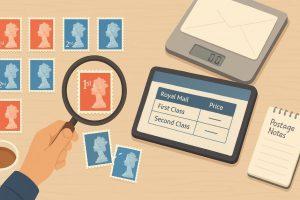
As of July 2025, the cost of a First Class stamp is £1.35, and a Second Class stamp costs £0.85 for standard letters up to 100 grams. These prices apply across all UK addresses and cover delivery from Monday to Saturday.
Here’s the updated pricing table for letters and parcels:
| Mail Format | Weight Limit | 1st Class (£) | 2nd Class (£) |
| Letter | Up to 100g | £1.35 | £0.85 |
| Large Letter | Up to 100g | £2.10 | £1.55 |
| Large Letter | 101–250g | £2.70 | £1.95 |
| Small Parcel | Up to 1kg | £4.69 | £3.49 |
| Medium Parcel | Up to 2kg | £6.99 | £5.49 |
These prices are consistent across the UK due to Royal Mail’s universal pricing policy.
Why Does Royal Mail Increase Stamp Prices?
Inflation and operational costs
Rising expenses related to transport, staffing, and delivery logistics have significantly increased Royal Mail’s operational costs in recent years. To cover these expenses, stamp prices are adjusted annually, usually in March or July.
Decrease in letter volume
Digital alternatives like email and online billing have significantly reduced the volume of traditional letters. As fewer people send physical mail, Royal Mail’s cost-per-letter increases, which affects the base price of stamps.
Universal Service Obligation (USO)
Royal Mail must deliver six days a week to every address in the UK. This includes remote and rural areas where delivery costs are higher. The expense of fulfilling this nationwide service mandate is reflected in stamp pricing.
What’s the Difference Between 1st and 2nd Class Mail?
Speed and priority
First Class mail is prioritised in the sorting and delivery process and typically arrives the next working day, including Saturdays. Second Class mail is more affordable and usually arrives within 2–3 working days.
Price and use case
First Class is ideal for urgent documents and time-sensitive communication. Second Class is commonly used for personal letters, bulk business mail, and items that don’t require immediate delivery.
Where Can You Buy First and Second Class Stamps?
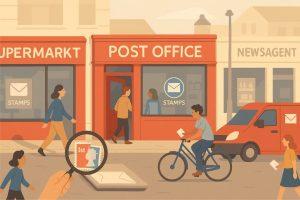
Online via Royal Mail’s official website
The easiest way to buy stamps is through Royal Mail’s Click & Drop platform. This service allows users to:
- Purchase barcoded stamps
- Print postage labels at home
- Arrange parcel pickups from home or business addresses
At Post Offices and retail stores
Stamps are also available at:
- Post Office branches
- High-street retailers (WHSmith, Ryman)
- Supermarkets (Tesco, Sainsbury’s)
- Newsagents and convenience stores
Most retailers offer stamp booklets in packs of six or twelve, providing a convenient option for regular senders and occasionally at a reduced rate.
What Are Barcoded Stamps and Why Are They Required?
Introduction of 2D barcoded stamps
In 2023, Royal Mail introduced barcoded stamps to enhance delivery accuracy, add digital functionality, and strengthen anti-fraud measures. As of 31 July 2023, only barcoded stamps are valid.
Swap Out scheme for old stamps
Anyone holding older, non-barcoded stamps can trade them in through Royal Mail’s official Swap Out programme to receive updated, valid replacements. The process is free and can be done via post by filling out a form available on their website.
Can You Save Money on Postage?
Use Second Class where possible
For non-urgent mail, Second Class is a smart, budget-friendly option. You save £0.50 per letter, which adds up over time, especially for businesses or frequent senders.
Buy stamps before price increases
Royal Mail usually announces price changes in advance. Buying stamps ahead of these hikes ensures you pay the current rate, even if you use them later.
Use Royal Mail Business Accounts
For SMEs and high-volume senders, Royal Mail offers business accounts with discounted rates, batch processing tools, and monthly invoicing.
How Do Stamp Prices Compare to Couriers?
While Royal Mail provides nationwide coverage and affordability for small letters, couriers can be more competitive for parcels, especially for tracked or next-day delivery.
| Service Provider | Service Type | Starting Cost | Tracked | Delivery Speed |
| Royal Mail | 2nd Class Parcel | £5.49 | No | 2–3 Days |
| Evri (Hermes) | Standard Parcel | £2.99 | Yes | 2–4 Days |
| DPD | Next Day | £6.99 | Yes | Next Day |
| ParcelForce | Express 48 | £7.99 | Yes | 2 Days |
Royal Mail remains the preferred choice for letters, documents, and low-weight parcels, but alternative carriers may offer better rates for bulk or urgent deliveries.
What Should You Avoid When Using Stamps?
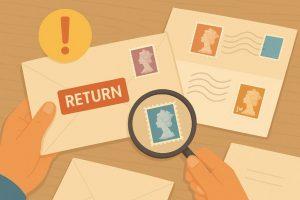
Underpaying postage
Using the wrong stamp or weight estimate may result in surcharges for the recipient. It’s essential to weigh and measure your item accurately or get it checked at the Post Office.
Using expired or non-barcoded stamps
From 2025 onward, non-barcoded stamps are invalid. Attempting to use them could delay your mail or result in it being returned.
Assuming you can reuse stamps
Stamps are strictly single-use. Attempting to reuse them is not only against Royal Mail’s terms but could be considered fraud.
What Are the Delivery Timeframes for UK Stamp Services in 2025?
Expected arrival times for First and Second Class
In 2025, First Class mail generally arrives at its destination within one working day, including Saturdays. This service is prioritised throughout Royal Mail’s network and is designed for urgent or time-sensitive items such as legal documents, formal invitations, or business correspondence.
Second Class mail is more budget-friendly but slightly slower, with expected delivery within two to three working days. While it’s not guaranteed, the vast majority of Second Class mail reaches its destination within this timeframe, making it ideal for general letters, cards, and non-urgent items.
Factors that may affect delivery speed
Although Royal Mail strives to meet its delivery promises, certain variables may impact how quickly an item is received. These include bad weather, postal strikes, incorrect addressing, or seasonal surges (like during Christmas or Black Friday). Urban areas like London tend to experience faster delivery, while rural or remote addresses may face slight delays.
To ensure timely arrival, it’s best to post items before the final collection time of the day and use clear, accurate addressing with the correct postcode.
What Tools Can Help You Calculate Postage Accurately?
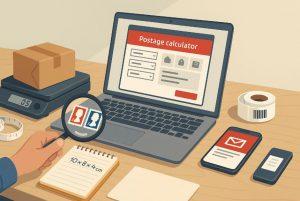
Using Royal Mail’s Price Finder
Royal Mail’s Price Finder tool is an essential resource for determining the exact cost of postage based on item size, weight, and destination. Whether you’re mailing a letter within the UK or sending a parcel abroad, the tool ensures that you choose the correct stamp or service without overpaying or underpaying.
To use the tool:
- Visit royalmail.com/price-finder
- Select the type of item you’re sending
- Enter the weight and dimensions
- Choose the destination (UK or international)
- View available services and costs instantly
This tool is especially helpful for small businesses, online sellers, and anyone unsure about stamp pricing for larger or international items.
Mobile apps and in-store weighing services
Royal Mail also offers a mobile app that allows users to check prices, print postage, and even track deliveries. For those without a scale at home, visiting a local Post Office or parcel drop-off point provides accurate weighing and pricing advice from trained staff.
By using these tools, you reduce the risk of underpaid postage and gain confidence in your mailing process whether you’re sending one letter or managing bulk dispatches.
Conclusion
To answer the main question how much is a 1st and 2nd class stamp cost in the UK as of July 2025, the prices stand at £1.35 for First Class and £0.85 for Second Class. First and Second Class postage continue to play a vital role in supporting both everyday communication and business mailing needs.
By staying informed and choosing the right service level for your needs, you can manage costs effectively while ensuring timely delivery across the UK.
FAQs
How long does First Class mail take to arrive?
Usually, First Class mail arrives the next working day, including Saturdays.
Can I still use old stamps?
Only barcoded stamps are valid as of July 2025. Non-barcoded stamps must be exchanged via Royal Mail’s Swap Out scheme.
What if I underpay for postage?
The recipient may be charged or the item returned. Always check weight and size before posting.
Is Second Class reliable?
Yes. Second Class is slower than First, but still dependable for non-urgent deliveries.
Can I track mail sent with a stamp?
No, standard stamps do not include tracking. Use “Signed For” or “Tracked” services for that feature.
Where can I check stamp prices?
Use the Royal Mail Price Finder tool for real-time costs and service options.
Do stamp prices include VAT?
Postage for standard letters and parcels is VAT-exempt under Royal Mail’s universal service obligation.








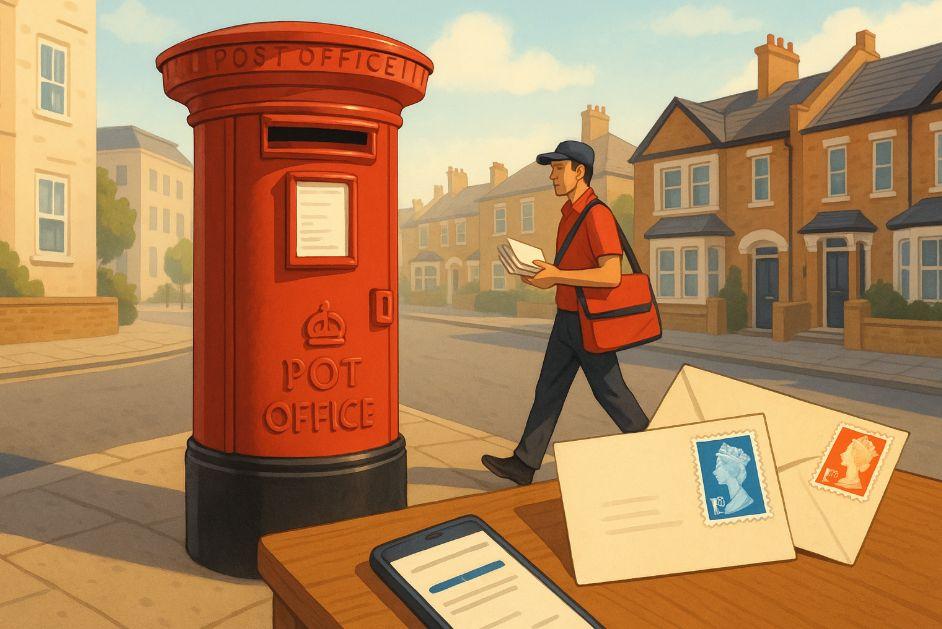
Leave feedback about this